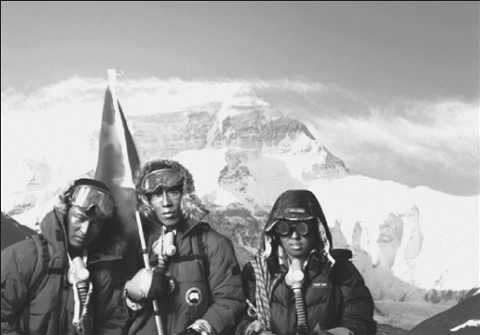By Debra Jenks
Artists examine the state of being in between
Everyone loves a good hoax, like P.T. Barnum’s Fiji Mermaid or Orson Wells’ alien invasion. These infamous and artful pranksters have something in common with the art and artifice of Xu Zhen. It seems impossible that decades after the advent of television, a supposedly media savvy public could still be hoodwinked. But belief in the calculated claims of Iraq’s connection to 9/11 (so fervently promoted by the mainstream media), and the ever-elusive weapons of mass destruction is proof that some of us can still be fooled.
Xu Zhen’s art probes the threshold of our gullibility through the conflation of fact and fiction. Skeptical inquiry meets conspiracy theory. His show revolves around the accusations that NASA faked the Apollo Moon landing in order to get there before the Soviet Union (or as a distraction from the Vietnam War).
In the first of three components of the show, Zhen creates his own conspiratorial event. “8848-1.8” is a short video that “documents” Zhen and two other climbers removing a 1.86 meter of Mt. Everest during a heavy snowstorm. Mimicking the television reception of that grainy black and white image transmitted from the Moon in 1969, the blizzard conditions in “8848-1.8” hinder our visibility. It’s not possible to be clear about what is actually taking place. Subtitle instructions give us a blow-by-blow account of the event, while primitively drawn arrows direct us to the ambiguous activity explained through a translator. The three featureless figures appear to saw off the peak, subsequently giving it a push down the mountain. Missing from this show is the refrigerated case (shown in Japan at the Yokohama International Triennale), containing the slice of Mt. Everest. An even more difficult feat than Zhen’s choreographed decapitation, might have been getting this “artifact” from Shanghai to the U.S. without it melting.
In the main room of the gallery is a piece entitled “It.” A microscope sits on a stainless steel table and we are invited to examine a speck of mud with a Lilliputian footprint, a replica of Neil Armstrong’s first footprint on the Moon. Blending the fallacious and the evanescent, ëIt” confounds the boundary separating science from fiction.
“18 Days,” the third piece in the show, documents an 18-day road trip across China that Zhen took with a group of collaborators. With an arsenal of remote-controlled toys (tanks, a battleship, helicopter and plane), the group sets out to “invade” the neighboring countries of Myanmar, Mongolia and Russia by crossing the borders with their battalion of tiny artillery. Like Armstrong’s footprint, we are once again looking at the world in miniature, and like “8848-1.8,” the frenetic movement of the camera keeps us straining (to the point of exhaustion) to see what is going on. One attempt after another fails, as Zhen and his cohorts get waylaid by bad weather and border guards. Tanks get stuck in tall grass and the battleship gets caught in a swift current, before finally reaching the shore of Myanmar. The successful river crossing is anti-climatic compared to the quixotic machinations Zhen goes through to realize an absurd purpose.
The photographs of Bertien van Manen portray a different set of borders. “A Hundred Summers, A Hundred Winters” is the result of van Manen’s travels through the former Soviet Union from 1990 to 1994, after the declared end of the Cold War. Many of the images elicit an aura of in between, a semblance of what’s left and what has yet to arrive, or what’s hidden and revealed.
In “Tomsk (Railway Station)” a woman sleeps awkwardly squeezed between the metal arms of a train station bench, while a blue snowdrift presses in on her through a large window. She is penned in by both internal and external circumstance. “Apanas, (Michael and Pjotr after Bath-House)” shows two men standing barefoot in the snow of a junk-strewn yard. They pour buckets of steaming water over their heads, which hangs like a frozen fountain or crystallized chandelier of tears around their bodies.
“St Petersburg, (Birds in Room)” looks like a set from a Hitchcock film. The residents of this rust-colored room with its peeling walls have flown the coop. Its only inhabitants are crows and pigeons that fly about or perch on stacked furniture and the bare curtain rod above an open French door. The emphasis here is on what has left or taken flight.
Another unoccupied room is “Rybinsk, (Sasha’s Attic Room).” As in “Tomsk (Railway Station),” we seem to be waiting for someone to return. There is a similar feeling of being penned in, not by emptiness, but by the competing patterns of mismatched wallpaper, curtains, and scraps of accumulated memorabilia. Two leather suitcases substitute for a night table. A folk painting that hangs above a small iron bed depicts a young girl in a blue dress gazing towards a distant lake. Perhaps she is a stand-in for Sasha, dreaming of something that has yet to arrive.




































